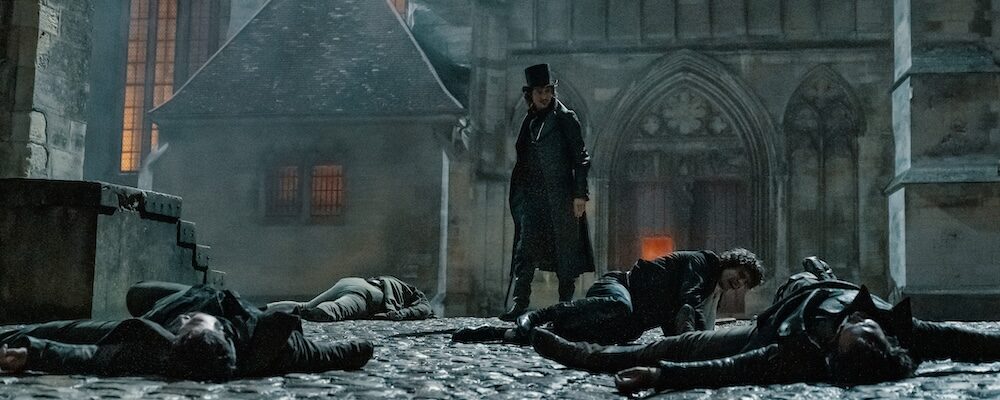‘The Count of Monte Cristo’: Alexandre Dumas’ Classic Comes Alive in Thrilling French Epic
Sandra Miska
Alexandre Dumas’ beloved 1844 adventure novel about betrayal, revenge and redemption in post-Napoleonic France gets an epic adaption with French filmmakers Matthieu Delaporte and Alexandre de La Patellière’s “The Count of Monte Cristo.” Pierre Niney plays the titular character, Edmond Dantès, a young sailor from a modest background who, after a long stint of being wrongfully imprisoned followed by a successful treasure hunt, takes on the persona of a wealthy and mysterious count in order to extract some much-deserved revenge on his enemies. It is rare that a period drama based on a centuries-old novel can be such a sweeping, Blockbuster-style feature.
As Dumas’ novel runs 1200-1300 pages in length, depending on the edition, there is a wealth of material for filmmakers to draw from. “The Count of Monte Cristo” has it all – romance, intrigue, suspense, action, moralism, etc. While the most recent major adaptation before this one, the 2002 American feature starring Jim Caviezel, focused heavily on the main love triangle and a life-affirming message, this darker French version is more expansive in its scope, including more characters from the novel, as well as adding a few new ones. One of the original characters is the brave admirable Angèle (Adèle Simphal), whom Edmond rescues from drowning in the film’s opening, defying orders from his captain, Danglars (Patrick Mille). On Angèle’s person is a letter from the exiled emperor Napoleon, which comes to be important.
The first act follows a lot of the same beats of the novel. Edmond is promoted to captain, Danglars is fired, and Edmond proceeds to propose to his devoted girlfriend, Mercédès (Anaïs Demoustier). The young couple is madly in love, which secretly causes Edmond’s best friend, Fernand de Morcerf (Bastien Bouillon), the son of a count, to seethe with envy, as he wants Mercédès, his cousin, for himself. Too sweet and earnest for his own good, poor Edmond is blindsided when he is arrested on his wedding day and thrown into prison for allegedly conspiring with Napoleon. Fernand, along with Danglars and a third man, a prosecutor named de Villefort (Laurent Lafitte), are behind this shocking act of injustice.
Betrayal and 14 years in a terrifyingly remote prison, the first four in solitary confinement, can certainly change a man, even one as seemingly pure of heart as Edmond. In lockdown, he befriends the wise and learned Abbé Faria (Pierfrancesco Favino). Not only does the abbé become his friend, mentor and tutor, he also gives Edmond a treasure map for buried loot on the island of Monte Cristo. After the old man’s death allows him to make a daring escape, he returns to his hometown and discovers that not only has his father died, Mercédès and Fernand have married. Devastated, he goes for a plan B, finding the treasure and reinventing himself as the mysterious and wealthy Count of Monte Cristo.
At first, Edmond has clear objectives, to repay those who had shown him kindness in his past life, and to take revenge on those who betrayed him. He enlists de Villefort’s illegitimate teen son André (Julien de Saint Jean) and an orphan named Haydée (Anamaria Vartolomei) to assist him with his schemes. A third teen, Mercédès and Fernand’s son Albert, is drawn into Monte Cristo’s web. These young people help the fake count hold onto his humanity, and Niney is terrific as Edmond’s black and white actions become increasingly gray.
The most memorable scenes in “The Count of Monte Cristo” are the ones in which Edmond/Monte Cristo keeps the viewer on the edge of their seat holding their breath. The best example of this takes place at a drawn-out dinner party in which he breaks bread with all three of his betrayers. The only person in his new life who recognizes him as Edmond is Mercédès. The old lovers’ scenes together, tender ones tinged with tragedy, are another highlight of the film, and Demoustier is heartbreakingly great. And one cannot ignore the lush sets and eye-catching costumes, especially the dresses worn by the women.
One critique here is that Edmond’s revenge plan against Danglars, which includes him impersonating another fake aristocrat, this time a boorish British lord, is drawn-out, although it does culminate in a satisfying courtroom scene. It would have been better to have spent more time on Fernand, the biggest villain of them all, partly because his betrayal of his former best friend was so personal. All of this leads to beautifully bittersweet but hopeful resolution.
“The Count of Monte Cristo” releases Dec. 20 in select theaters and expands Jan. 3 in theaters nationwide.

